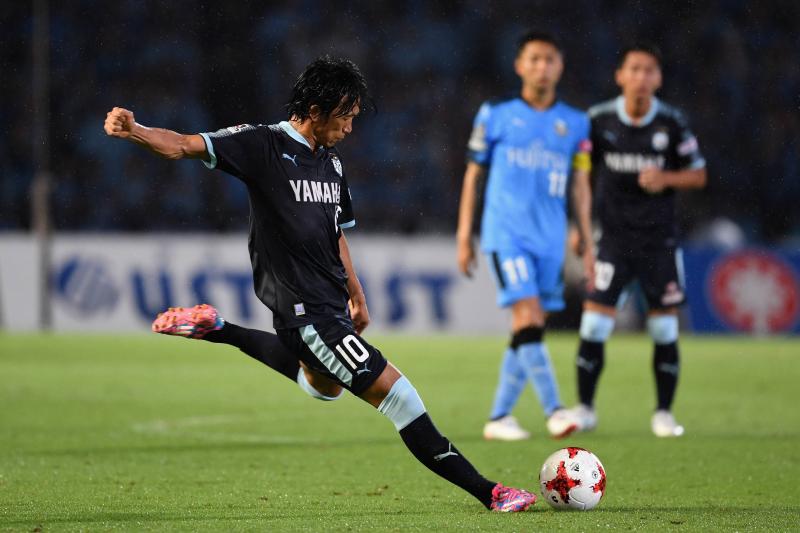
Shunsuke Nakamura turned 39 years old on July 24. Yet despite his age, he is still among the best players in the current J1 League season, helping a previously-discredited Jubilo Iwata side compete for a top position while beating many title contenders along the way.
The former Samurai Blue star, an icon in Japanese football history, continues to showcase his talent on the field and week after week proves he can still perform at a high level. His controversial transfer from Yokohama to Iwata, ended up being positive for everyone, even his former club Yokohama F. Marinos who have overcome their dependency on the playmaker and, without much fuss, are also competing for first place.
This weekend Jubilo’s No. 10 was once again decisive, creating the equaliser against second-placed Cerezo Osaka just four minutes from injury time. Nakamura’s effort from outside the area forced Kim Jin-hyeon to make a difficult save, parrying the ball for a corner. Noting the lack of Cerezo defenders close by, Nakamura opted for a short corner, received the ball back from teammate Hayao Kawabe immediately and delivered a cross from near the penalty area. Kengo Kawamata won the aerial duel with Tatsuya Yamashita and headed home, earning a deserved ninth goal of the season and salvaging a 1-1 draw.
Nakamura’s assist was undoubtedly the highlight of his performance, but his ball distribution and defensive awareness were also top notch. He even sprinted for more than half the field during one Cerezo counter, making a crucial tackle inside the box to prevent what would have been a certain goal by Yusuke Maruhashi. He covered the third-longest distance on the field (10.981 meters), second only to Kawabe (11.101m) and Yamaguchi (11.279m). With his great physical condition, Nakamura has already surpassed the number of matches he played in each the last two seasons.
Shunsuke Nakamura’s last three seasons:
2015 (Yokohama F. Marinos): 19 games, 15 starts, 3 goals, 5 assists
2016 (Yokohama F. Marinos): 19 games, 17 starts, 4 goals, 5 assists
2017 (Iwata, through Round 23): 20 games, 20 starts, 3 goals, 7 assists
It must be emphasized that Nakamura is not the only explanation for Jubilo’s good season. Their defence, a weak point last year, currently boasts the second-fewest goals conceded in the J1 and is the cornerstone of 44-year-old Hiroshi Nanami’s 3-4-2-1 formation. The young manager is a rare case of a Japanese club idol who has succeeded both as player and as coach. While their system is identical to that of oft-criticized Urawa Reds, Jubilo’s approach is totally different, demonstrating an ability to compensate for lack of talent at some positions with tactical organization. With the fourth-lowest ball possession average in J1 (44%), Jubilo have found success playing what could be called “reactive football.” It is not only Nakamura: Kentaro Oi, Krzysztof Kaminski, Kawabe, Fozil Musaev, Kawamata, and Adailton are all having excellent seasons too.
At the beginning of the season few could imagine Jubilo standing in the top half of the table by this point, and the same could be said of Yokohama F. Marinos. Supporters were not happy with the return of French manager Erick Mombaerts, and many objected to the release of several veterans who had been all but expected to retire as Marinos players. It is true that the Tricolore started the season inconsistently, but they quietly started to pile up good results and are in the midst of a 13-match unbeaten streak during which they have earned 31 out of 39 possible points.
How is it possible? Marinos don’t exactly play eye-catching football and frequently struggle on the attack. Hugo Vieira has yet to establish himself as a scoring machine. Macedonian midfielder David Babunski has steadily declined since Round 2, with just one start since mid-May. Jun Amano, who has inherited the role of midfield distributor, cannot be compared to Nakamura. The team’s real strength on offense is in their speed up the wings. Newly-assigned captain Manabu Saito has not opened his J1 account this season, but his eight assists trail only Kashiwa Reysol’s Cristiano, who stands at nine. Speedster Martinus has become a powerful counter-attacking weapon, with five goals and four assists so far.
Meanwhile, the Marinos defense has been impeccable and is arguably the best in the league. Hiroki Iikura may not be the most reliable goalkeeper, but he commits few mistakes and is well protected by evergreen centre-back Yuji Nakazawa, the 39-year-old veteran who last missed a start in 2012, and by emerging Socceroo regular Milos Degenek. Ken Matsubara and Ryosuke Yamanaka have boosted the team’s strength at fullback.
The team’s biggest surprise, Takahiro Ogihara, has dominated the Tricolore midfield and become an indispensable presence. The volante failed to stand out for Cerezo Osaka in the J2 and will not be missed at Nagoya Grampus after his underwhelming stay there last year, but at Nissan Stadium he has recovered his top form, recalling the promise he held as a member of the London 2012 generation. It is not an exaggeration to say that he is the signing of the year for Yokohama.
While casual J.League followers outside of Japan may have been surprised to see Nakamura trade in the dark blue of Yokohama F. Marinos for the saxe blue of Jubilo Iwata, they can rest assured that both he and his former club are prospering.
Tiago Bontempo is a Brazilian journalist specializing in Japanese football for Globo. He can be found on Twitter at @GunnerTNB


